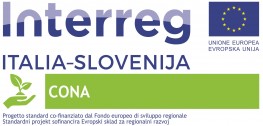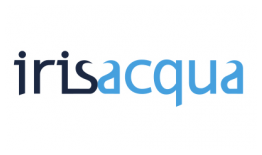Preserving and protecting the environment and promoting resource efficiency.

Protecting and promoting natural and cultural resources
The project’s main objective was to protect and improve the aquatic ecosystem and its biodiversity in order to ensure the sustainable development of the project area, and to help achieve the program’s specific objectives. The project focused on the development of innovative solutions using the most advanced knowledge on a European-wide scale, which lead to concrete results in the cross-border area.
From a biodiversity standpoint, the Italian/Slovenian cross-border area is certainly one of the richest and best preserved in all of Europe. With the realisation that nature knows no boundaries, the CONA project’s partners decided to join together in an effort to protect this shared natural heritage. The constant pollution of the water has caused so many changes to the aquatic ecosystem that a harmful balance has been created for living organisms. The Corno river is in extremely poor condition, and this has even had a negative impact upon the quality of the Isonzo river.
The main objective was to improve the ecological status of the aquatic ecosystem and to protect biodiversity in order to ensure progress and sustainable development. The project was focused upon the water catchment area of the Corno river, which is also part of the Isonzo river basin, and flows into the Adriatic in the protected area of Cona Island. All the work activities planned within the Corno catchment area were aimed at improving the water quality, thus improving the conservation status of the species and habitats. One important part of the project was the investment in the Municipality of Monfalcone, which had a major impact in terms of directly reducing the environmental pressure upon the protected area of Cona Island, in the heart of the nature reserve. The main cross-border outputs at the project level were the development and installation of weather stations and equipment, as well as the drafting of the project idea concerning re-naturalisation of the Corno river, which will have a direct impact upon the Isonzo catchment area and the nature reserve. The initiative represents an important opportunity to proceed with the joint planning, with particular focus being placed upon the sustainable management of the water resources in order to prevent environmental and ecological risks.
The project’s main objective was to carry out interventions aimed at guaranteeing sustainable ecosystem services with the help of green technologies. A reduction in the wastewater emptied into in the Corno river and the Adriatic will also have a positive impact on the conservation status of habitats and species. This will reduce environmental pollution and will improve the chemical-physical state of the water. By improving the ecological status of the Corno river, and consequently that of the mouths of the Isonzo river, a proper balance will be restored within the “Isola della Cona” nature reserve, thus increasing its self-cleaning capacity and biodiversity. The re-naturalisation of the Corno river involved the use of green technologies (sewage ditch and meandering course) and eco-remedies (natural systems and processes for the protection and renewal of the environment). With the re-naturalisation of the watercourse, long-term sustainability and economic management will be guaranteed. Eco-remedies primarily serve to improve self-cleaning capacities, as they protect natural habitats and biodiversity. With eco-remedies, the water is successfully retained, creates a new habitat, and eliminates residual pesticides and other nutrients present due to agricultural activities. In this manner, important areas of the ecosystem are protected from pollution, while at the same time allowing for sustainable ecological development in the cross-border area.
Lead Partner

Project partner 1
Project partner 2

| Poster evento annuale 30/05/2018 CONA_ITA.pdf ( 717 bytes, published on 11 June, 2018 - 17:44 ) | |
| Brošura projekta CONA_Brochure di progetto CONA.pdf ( 5 bytes, published on 7 December, 2020 - 15:00 ) | |
| Articolo Il Piccolo_CONA 131892587_3650532691733250_3167832632564151413_o.jpg ( 419 bytes, published on 2 September, 2021 - 13:07 ) | |
| Articol Primorske novice_CONA SDevelop22720121712590.pdf ( 335 bytes, published on 2 September, 2021 - 13:07 ) |
THE MAIN COMMON GOAL OF THE PROJECT
The main common goal of the project was the protection and improvement of the protection of the aquatic ecosystem and biodiversity for the sustainable development of the project area, which contributes to the achievement of the program specific goal. The project focused on the development of innovative solutions using the latest knowledge at the European level, which bring concrete results in the cross-border area.
STATUS OF IMPLEMENTATION AT THE END OF THE PROJECT (31.12.2020)
As part of the CONA project, partners completed all planned activities by December 2020. The following activities were carried out:
PREPARATION OF PROJECT DOCUMENTATION FOR THE RECONSTRUCTION OF UNLOADERS ALONG THE KOREN STREAM ON THE ITALIAN SIDE
Irisacqua S.r.l., in the context of the CONA project, prepared project documentation for the relief and restructuring of overflow drains along the Koren stream. The mixed-type Gorizia communal-canalization network is equipped with 34 drainage channels for floods and overflows, of which 16 drains separate the water by supplying liquid meteor water to Koren collector. The reconstruction of the loaders, foreseen in the conceptual design, reduced the environmental impacts and releases.
As part of the project implementation, the following works were implemented on individual loaders:
ANALYSIS OF THE EXISTING SITUATION AND PREPARATION OF A CONCEPTUAL DESIGN WITH A PROPOSAL FOR MEASURES OF SUSTAINABLE REGULATION (GREEN INFRASTRUCTURE) ALONG THE KOREN STREAM ON THE SLOVENIAN SIDE
Koren stream is the only watercourse in the narrower part of Nova Gorica. The area around the regulated watercourse represents a sort of dividing line between the urban part of the town and the green Panovec. The existing riverbed is an in-depth channel that used to drain the city's stormwater and wastewater. The lathe is not currently attractive for enjoying the water.
With the CONA project, we set a goal to take some measures along the watercourse and the main containment pool to take measures to improve the situation and to give different views of the regulation of the riverbed and the nearby area. Project partner VIK set several goals:
The first objective was realized by designing the conceptual design of the revitalization of the Koren stream. The basis for the conceptual design was the document Determination of the Biodiversity Function of the Water and Bypass Area of the Koren Stream, based on the inventory of flora and fauna upstream and downstream of the Pikolud reservoir. The conceptual design covers a part of the Koren Canal, which runs in the urban area of Nova Gorica, approximately 1.2 km in length, from the Pikolud barrier to the confluence of the Prakrit section along the national border.
DEVELOPMENT OF AN APPLICATION FOR ONLINE DATA MONITORING
The data sent by the twelve devices are captured and entered into the database on the server of the School Center Nova Gorica. The data is captured each time the station sends it, so the capture interval is not predetermined. The saved data is then displayed in a web application.
The application on the entry page shows the locations of the devices and the latest measurements at each station (temperature, humidity, amount of precipitation). As it is desirable to also have data on the meteorological alarm, freely available data from the ARSO - Environmental Agency of the Republic of Slovenia are also shown. For each station, you can also view the details of measurements at that station in one day, a week or a month, and you can view data about an individual station live. The web application was created by a student of Vocational College of School Center Nova Gorica.
The web application is available at http://www.h2ocona.eu
The works in this set include:
The application makes it possible to monitor the state of precipitation and sewage network in real time on the basis of new data, as well as to determine the amount of unloaded water. At the same time, the flow of wastewater from the area of Nova Gorica to the Central Wastewater Treatment Plant in Nova Gorica is also shown. These data allow the preparation of a treatment plant according to the current conditions (eg. unusual inflow of wastewater, first precipitation wave).
DEVELOPMENT, IMPLEMENTATION AND MAINTENANCE OF METEOROLOGICAL STATIONS
In the CONA project, the School Center Nova Gorica, Vocational College received the task of manufacturing 12 devices that would measure the current and cumulative amount of precipitation and transfer data via the Internet to the control rooms of treatment plant. The project partners determined the locations of the measuring stations, and the students of informatics and mechatronics had to find a way with their mentor how to make the device and how to solve the data transfer problem.
To perform the measurements, they chose a "rain gauge" or "pluviometer", namely one with a "tipping bucket", because it allows the measurement of both set quantities - current and cumulative rainfall. Students made the »rainmeter« with a help of a mentor. In the 3D modeling program, they drew the components of the »rainmeter«, which they printed with the help of a 3D printer and assembled the meter. Then it was necessary to look for solutions that would allow the transfer of collected data to the Internet.
The relatively new LoRaWAN technology has proven to be an ideal solution. The abbreviation LoRaWAN consists of the English words Long Range Wide Area Network. This is a protocol designed to network low-power devices over long distances. The LoRaWAN network consists of gateways and end devices.
Passages are radio stations that are connected to the Internet. Terminal devices are usually battery-powered "smart" low-power radios that communicate wirelessly with one or more passages. Communication can take place in both directions. The technology enables the slow transfer of small amounts of data over long distances, reaching 10 km in the open.
Due to the extremely low power consumption when using this protocol, the devices can operate for many years on battery power. This eliminated the cost of solar cells. Since the freely available 868MHz frequency band is used for communication, there are no royalties. When the project started, two crossings were active in the wider area of Nova Gorica. They anticipated that they would need at least 5. In 2019, there are 12 active crossings on the Slovenian side of the border and 5 crossings on the Italian side, which are completely sufficient to cover the locations of measuring stations.
They also made the electronic circuit of the device themselves. It consists of a microcontroller that consumes only 1 µA of current and a radio transmitter module in economy mode. The microcontroller program was written to send data every two minutes in the event of rainfall. If there is no precipitation, the device sends data on the temperature and relative humidity measured at its location every half hour.
ESTABLISHMENT OF AN OPTIMAL CONTAINMENT SYSTEM FOR THE FIRST PRECIPITATION WAVE AND MINIMIZATION OF SPILLED WASTEWATER INTO THE KOREN STREAM
The retention pool on Erjavčeva street is intended for the collection and pumping of wastewater from the entire agglomeration ID 1515 Kromberk. As part of the project, in accordance with the set tasks, we procured and installed new rakes, which serve to remove dirt from the sewer system. These separated particles represent an impermissible load on the treatment plant and therefore the system for collecting this dirt is very important. To improve the pumping process, two new pumps with complete process technology were installed.
The installed new equipment and applications will help to increase control and optimize and reduce energy consumption in the process of wastewater disposal in the city of Nova Gorica.
RECONSTRUCTION OF UNLOADERS NEAR THE NATURA 2000 PROTECTED AREA.
Irisacqua S.r.l. as part of the CONA project, carried out project interventions for the adaptation and insurance of four unloaders in the area of the municipality of Monfalcone.
The works included the reconstruction of unloaders, with the aim of reducing and controlling discharges into surface waters. The outflow channels were equipped with cleaning and bypass devices.
The main objectives achieved can be summarized as follows: At the planning level, the project developed documents containing indications for the adjustment of emissions, installation of weather stations and equipment, as well as the re-naturalization of the Koren stream, which is being implemented through restructuring. The reconstruction of unloaders will have a direct impact on the Soča river basin and on the Isola della Cona nature reserve.
At the same time, the processes envisaging the adaptation and protection of the four straits in Monfalcone will have a direct impact on reducing environmental pressure on the protected area of Cona Island, the heart of the nature reserve, ensuring the ecological status of the aquatic ecosystem and protecting biodiversity to ensure sustainable development and progress.
The initiative represents an important opportunity to continue joint planning, with a special focus on sustainable water management, with a view to preventing environmental and ecological risks, by paying further attention to the dissemination and publication of the activities carried out.
In December 2020, the partners organized the final conference of the project, where they presented all the results of the CONA project to the general public.